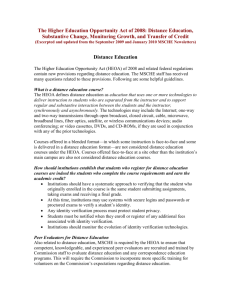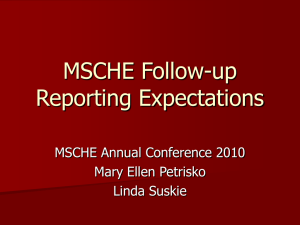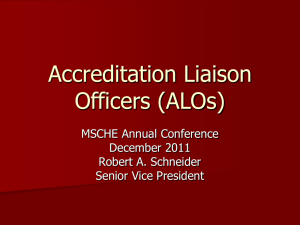Understanding Federal Compliance Expectations for the Periodic
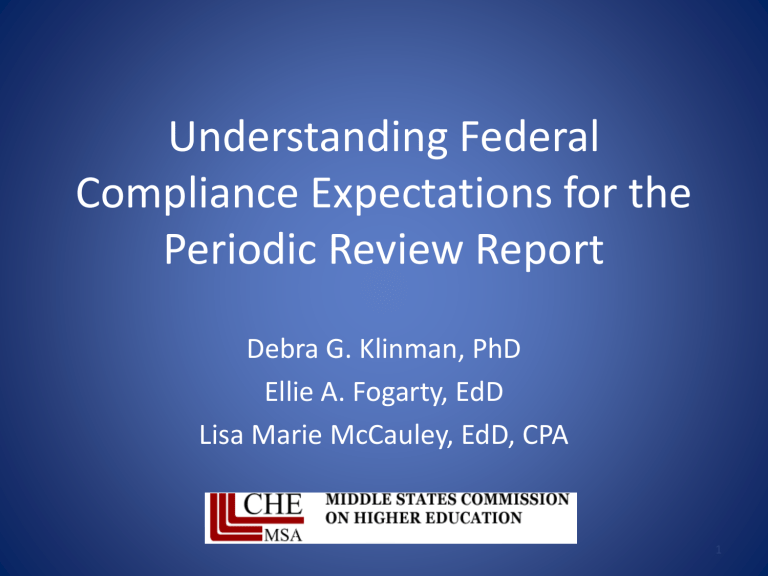
Understanding Federal
Compliance Expectations for the
Periodic Review Report
Debra G. Klinman, PhD
Ellie A. Fogarty, EdD
Lisa Marie McCauley, EdD, CPA
1
Overview
• Accreditation and Federal Compliance
– Past, Present, and Future (Emerging Issues)
• Current Expectations
– Certification Statement
– Areas of Review
– Additional Resources
• Procedures for Submission and Review
Middle States Commission on Higher Education 2
Accreditation and
Federal Compliance
Middle States Commission on Higher Education 3
Past
• Accreditation developed and evolved throughout the early 20 th century to promote mission-centered, continuous quality improvement through self-appraisal and peer review
Middle States Commission on Higher Education 4
Past
• HEA 1965 (with subsequent re-authorizations, including 2008) directed accreditors to serve as gatekeepers for institutional access to federal financial aid (Title IV)
• Verification of compliance with federal regulations became an ever-increasing part of the accreditation process
Middle States Commission on Higher Education 5
Present
• Federal financing has ballooned alongside rising institutional costs and cutbacks in state and local funding
• Accreditors continue to focus on quality improvement; the Department of Education sees the primary purpose of accreditation as safeguarding federal funds and ensuring institutional accountability
Middle States Commission on Higher Education 6
Present
• HEOA 2008 formalized compliance verification by accreditors in four specific areas (distance
& correspondence education, transfer of credit, credit hours, and cohort default rate)
• MSCHE verification procedures are now part of all accreditation reviews (Self-Study and
PRR)
Middle States Commission on Higher Education 7
Future (Emerging Issues)
• Next HEOA re-authorization is likely to be postponed until 2014 - 2015
• National voices include NACIQI (October
2011), ACE National Task Force on Institutional
Accreditation (June 2012), Obama administration (State of the Union, February
2013)
Middle States Commission on Higher Education 8
Future (Emerging Issues)
• Ideas that have been discussed include:
– Eliminating or modifying the link between accreditors and institutional eligibility for Title IV
– Instituting ‘baseline’ quantitative performance measures to be monitored by the federal government
– Differentiating accreditation procedures by mission
(sector, profit vs. non-profit) and ‘risk’ (prior history of performance and stability)
Middle States Commission on Higher Education 9
Future (Emerging Issues)
• Ideas that have been discussed include:
– Emphasizing measures of ‘value, affordability, and student outcomes’ in determining access to federal aid
(value = students’ ability to get jobs and pay off student loans)
– Developing an ‘alternative pathway’ for access to federal financial aid for innovative models of higher education (i.e., competency-based learning, MOOCS)
• The national dialog will continue in the months and years to come.
Middle States Commission on Higher Education 10
Current Expectations
Middle States Commission on Higher Education 11
Certification Statement
• Institutions affirm compliance with federal
Title IV requirements including:
– Distance and correspondence education (student identity verification)
– Transfer of credit
– Title IV cohort default rate
– Assignment of credit hours
• Signed by CEO and Board Chair
• Documentation reviewed by peer compliance reviewers
Middle States Commission on Higher Education 12
Middle States Commission on Higher Education
3624 Market Street, Philadelphia, PA 19104-2680
Phone: 267-284-5000 Fax: 215-662-5501 www.msche.org
Certification Statement:
Compliance with MSCHE Requirements of Affiliation and
Federal Title IV Requirements
Effective October 19, 2012
____________________________________________________________________________
(Name of Institution) is seeking (Check one) : ___ Initial Accreditation
___ Reaffirmation of Accreditation through Self Study
___ Reaffirmation of Accreditation through Periodic Review
An institution seeking initial accreditation or reaffirmation of accreditation must affirm that it meets or continues to meet established MSCHE Requirements of Affiliation and federal requirements relating to
Title IV program participation, including the following relevant requirements under the Higher Education
Opportunity Act of 2008:
Distance education and correspondence education (student identity verification)
Transfer of credit
Assignment of credit hours
Title IV cohort default rate
This signed certification statement must be attached to the executive summary of the institution’s selfstudy or periodic review report.
The undersigned hereby certify that the institution meets all established Requirements of Affiliation of the
Middle States Commission on Higher Education and federal requirements relating to Title IV program participation as detailed on this certification statement. If it is not possible to certify compliance with all requirements specified herein, the institution must attach specific details in a separate memorandum.
___ Exceptions are noted in the attached memorandum (Check if applicable)
__________________________________________
(Chief Executive Officer)
__________________________________________
_______________________
(Date)
(Chair, Board of Trustees or Directors)
_______________________
(Date)
13
Distance and Correspondence Education
• Distance Education
– Instruction delivered via technology
– Regular student/faculty interaction
• Correspondence Education
– Instructional materials delivered, mail or email
– Student initiated interaction as needed
Middle States Commission on Higher Education
Student Identity Verification
• HEOA 2008: How do institutions verify student identity in distance or correspondence education courses?
– Secure username and password
– Proctored exams
– New technologies
– Protection of student privacy
– Notification of student fees at registration
Middle States Commission on Higher Education
Verification of Compliance
Institutions submit the following along with their Periodic Review Reports:
Distance or Correspondence Education
Methods used to consistently verify student identity, protect student privacy, and notify students about cost
Middle States Commission on Higher Education 16
Transfer of Credit
• HEOA 2008: How do institutions publicly provide the following to students?
– Criteria for Transfer Decisions
– List of Articulation Agreements
Middle States Commission on Higher Education
Verification of Compliance
Institutions submit the following along with their Periodic Review Reports:
Transfer of Credit
Publicly disclosed policies and procedures for the transfer of credit and a list of all articulation agreements
Middle States Commission on Higher Education 18
Credit Hours
• Measurement of academic work AND economic metric
• Federal definition is consistent with the
Carnegie Unit
• State credit hour regulations, consistent with the federal credit hour definition, may be sufficient evidence of compliance
Middle States Commission on Higher Education
Credit Hours
• HEOA 2008: How does the institution ensure that its credit hour policies align with federal criteria? Does the institution’s assignment of credit hours conform to commonly accepted practice in higher education?
Middle States Commission on Higher Education
Verification of Compliance
Institutions submit the following along with their Periodic
Review Reports:
Assignment of Credit Hours
• Policies and procedures for assigning credit hours to all types of courses & programs
• Evidence that credit hours are accurately and reliably assigned
• A list of the courses & programs that differ from the federal definition of ‘credit hour’ with evidence that they conform to commonly accepted practice in higher education
Middle States Commission on Higher Education 21
Title IV Cohort Default Rate
• The percentage of students in a given fiscal year who cannot repay federal loans
• Each year, the US Department of Education calculates and publishes the average rate
• HEOA 2008: Is the institution’s 3-year cohort default rate within the federal limit?
Middle States Commission on Higher Education
Verification of Compliance
Institutions submit the following along with their Periodic Review Reports:
Title IV Cohort Default Rate
Documentation from USDE of the institution’s cohort default rate, audits of federal programs (A-133) for the past 3 years, relevant correspondence and institutional responses
Middle States Commission on Higher Education 23
Resources
US Dept. of Education http://www2.ed.gov/about/offices/list/ope/policy.html
http://www2.ed.gov/policy/highered/leg/hea08/index.html
Official Cohort Default Rates for Schools http://www2.ed.gov/offices/OSFAP/defaultmanagement/cdr.html
MSCHE Verification of Compliance with Accreditation-
Relevant Federal Regulations: Initial Implementation for
Spring 2013 http://www.msche.org/documents/ComplianceCriteriaSpring2013.pdf
Middle States Commission on Higher Education 24
Procedures for Submission and Review
Middle States Commission on Higher Education 25
Institutions
• The Compliance Documents should be contained in one PDF file that is indexed / bookmarked by each of the four compliance areas.
• PRR Institutions will upload documents to: www.MSCHE.org/MyCHE
• Submission upload is required by June 1 st same as PRR.
Middle States Commission on Higher Education
Peer Compliance Reviewers
• Peer Compliance Reviewers will use the information to prepare their report on the institution’s compliance.
• Peer Compliance Reviewers will upload their report of compliance verification by July 15th.
Middle States Commission on Higher Education
Institutions & PRR Reviewers
• The institution can review and respond to any non-compliance issues noted, by August 15 th .
• The PRR Reviewers will consider any additional response from the institution in the preparation of the Confidential Brief to the
Commission.
Middle States Commission on Higher Education
Questions?
• dklinman@msche.org
• efogarty@msche.org
• lmmccauley@msche.org
Middle States Commission on Higher Education 29
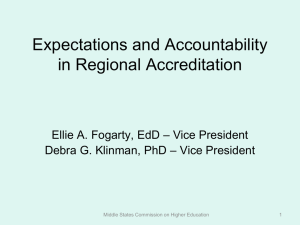
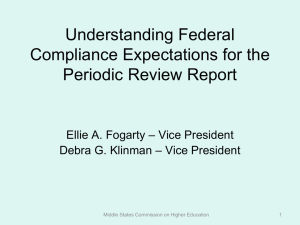
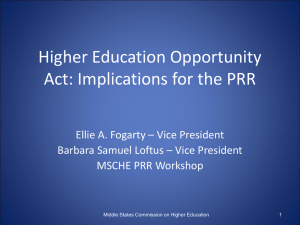
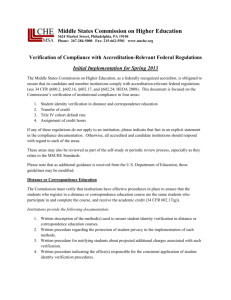

![Publication [Word, 67.5 KB]](http://s3.studylib.net/store/data/007511253_1-047acd67369e1c6b1af048da5016aff1-300x300.png)
